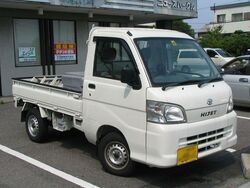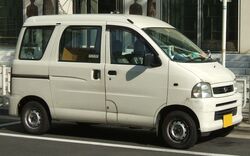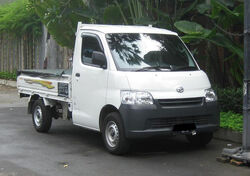m (...) Tag: sourceedit |
m (cat) |
||
| (2 intermediate revisions by the same user not shown) | |||
| Line 2: | Line 2: | ||
| image = [[File:DaihatsuHijet123.jpg|250px]]<br /><small>The ninth generation Daihatsu Hijet truck</small> |
| image = [[File:DaihatsuHijet123.jpg|250px]]<br /><small>The ninth generation Daihatsu Hijet truck</small> |
||
| name = Daihatsu Hijet |
| name = Daihatsu Hijet |
||
| − | | aka = [[Daihatsu Atrai]]<br>[[Daihatsu Extol]]<br>[[Daihatsu Grand Max]]<br>[[Daihatsu Zebra]]<br>[[Piaggio Porter]]<br>[[Toyota Sparky]] <br>[[Innocenti Porter]] <br>[[Toyota LiteAce]] |
+ | | aka = [[Daihatsu Atrai]]<br>[[Daihatsu Extol]]<br>[[Daihatsu Grand Max]]<br>[[Daihatsu Zebra]]<br>[[Piaggio Porter]]<br>[[Toyota Sparky]] <br>[[Innocenti Porter]] <br>[[Toyota LiteAce]](Japan)<br>[[Kia Towner]] |
| manufacturer = [[Daihatsu]] |
| manufacturer = [[Daihatsu]] |
||
| production = 1960–present |
| production = 1960–present |
||
| Line 21: | Line 21: | ||
[[File:Hijet-cargo.jpg|thumb|right|250px|The ninth generation Hijet Cargo.]] |
[[File:Hijet-cargo.jpg|thumb|right|250px|The ninth generation Hijet Cargo.]] |
||
| − | In Japan, the passenger car version of the Hijet is known as the |
+ | In Japan, the passenger car version of the Hijet is known as the [[Daihatsu Atrai]], which is also powered by a 660 cc Turbo engine producing {{convert|64|bhp|kW|0|abbr=on}}. |
The band Diehatzu Hijets, of similar spelling, pay homage to the vehicle. |
The band Diehatzu Hijets, of similar spelling, pay homage to the vehicle. |
||
| Line 28: | Line 28: | ||
== Variants == |
== Variants == |
||
[[File:PiaggioVanMikinos06474.JPG|thumb|250px|left|[[Piaggio]] Porter, based on the fourth generation Hijet]] |
[[File:PiaggioVanMikinos06474.JPG|thumb|250px|left|[[Piaggio]] Porter, based on the fourth generation Hijet]] |
||
| − | There are also versions of the Hijet sold outside [[Japan]], available with 1.0 and 1.3-litre engines. These are no longer considered [[kei car]]s, as they are wider and longer than allowed by these narrowly defined regulations. The |
+ | There are also versions of the Hijet sold outside [[Japan]], available with 1.0 and 1.3-litre engines. These are no longer considered [[kei car]]s, as they are wider and longer than allowed by these narrowly defined regulations. The [[Daihatsu Hijet Maxx]]/[[Daihatsu Hijet Jumbo]] is a pick-up truck or chasis cab which can be set up for other uses such as a moving stall. The [[Daihatsu Zebra]] (aka [[Daihatsu Citivan]]/[[Daihatsu Devan]]) is a van version of the Hijet Maxx. The [[Perodua Rusa]] is a rebadged Zebra sold by Daihatsu's Malaysian partner, [[Perodua]]. In the Japanese market, there was also a larger version of the ninth generation Hijet, sold as the [[Daihatsu Hijet Gran Cargo]]. This car has been exported as the [[Daihatsu Extol]] as well. |
[[File:DaihatsuGranMaxDLiPU.jpg|right|thumb|250px|Daihatsu Gran Max DLi pick-up in Indonesia]] |
[[File:DaihatsuGranMaxDLiPU.jpg|right|thumb|250px|Daihatsu Gran Max DLi pick-up in Indonesia]] |
||
| − | The |
+ | The [[Piaggio Porter]] is a licensed version manufactured in [[Italy]] since 1992 (originally as the [[Innocenti Porter]]), available also with diesel, LPG or electric motors. Originally equipped with a 1.0 petrol or a 1.2 litre diesel, more recent cars receive a 1,269 cc petrol/LPG engine or a 1,371 cc diesel.<ref>[http://www.xs4all.nl/~mjs/cabover.html Far East Auto Literature - Japanese Kei Minivans]</ref> The 1.3 offers {{convert|48|kW|PS|0|abbr=on|disp=flip}} in either configuration while the 1.4 diesel only manages {{convert|28|kW|PS|0|abbr=on|disp=flip}}.<ref>{{Citation | last = Calin | first = Mihaela | title = O noua provocare pe piata auto constanteana | trans_title = A new challenge for Constanţa's auto market | language = Romanian | url = http://www.romanialibera.ro/actualitate/fapt-divers/o-noua-provocare-pe-piata-auto-constanteana-75629.html | journal = Romania Libera | date = 29-09-2005 }}</ref> All of these Porter variants are based on the facelifted sixth generation of the Hijet (S82) which has its front wheel located below the front door and a mid-mounted engine. The S82 Hijet also provided the basis for the [[Kia Towner]]. |
| − | In 2007, [[Daihatsu Indonesia]] launched the new |
+ | In 2007, [[Daihatsu Indonesia]] launched the new [[Daihatsu Gran Max]] which is based on the newest Hijet ("semicab", front wheels located forward of the door). It is powered by 1,300 and 1,500 cc engines and is both wider and longer than the [[kei car]] based Hijet. It replaces the previous [[Daihatsu Zebra]] of similar size. The Gran Max is available in [[minivan]] and [[pickup truck|pick-up]] bodystyles and since February 2008 it is imported to Japan where it is sold as the [[Toyota LiteAce]] (S402). |
{{-}} |
{{-}} |
||
== Hybrid Hijet == |
== Hybrid Hijet == |
||
| − | In 2002, Daihatsu debuted the |
+ | In 2002, Daihatsu debuted the [[Daihatsu Hijet Cargo Hybrid]] [[concept car|concept]], a '''[[hybrid van]]''', in [[Japan]] using a 660 cc engine. The car is based on the existing non-hybrid Hijet Cargo. Daihatsu calls it a mild hybrid design. Its design (called Daihatsu Mild Hybrid System or DMHS based on Toyota hybrid technology) is quite different from many existing hybrid design where as the gas and electric powered components assembled as one unit. The electric motor sits between the gasoline powered engine and the transmission unit. The car is 30% more fuel efficient than its gas-powered counterpart. |
The '''hybrid [[minicar]]s''' (called FEV - Ultra Fuel Economy - and Atrai Hybrid-IV) made its debut in 2002 as a concept [[minicar]].<ref>[http://www.daihatsu.com/ir/library/pdf/annual02.pdf Daihatsu Motor Co., Ltd. - Annual Report 2002]</ref> Its production was announced in October 2004 but as of May 2006 had not been released. |
The '''hybrid [[minicar]]s''' (called FEV - Ultra Fuel Economy - and Atrai Hybrid-IV) made its debut in 2002 as a concept [[minicar]].<ref>[http://www.daihatsu.com/ir/library/pdf/annual02.pdf Daihatsu Motor Co., Ltd. - Annual Report 2002]</ref> Its production was announced in October 2004 but as of May 2006 had not been released. |
||
| Line 60: | Line 60: | ||
[[Category:Daihatsu vehicles|Hijet]] |
[[Category:Daihatsu vehicles|Hijet]] |
||
| ⚫ | |||
[[Category:Microvans]] |
[[Category:Microvans]] |
||
| ⚫ | |||
[[Category:Hybrid vans]] |
[[Category:Hybrid vans]] |
||
[[Category:Kei trucks]] |
[[Category:Kei trucks]] |
||
| Line 67: | Line 67: | ||
[[Category:Trucks built in Italy]] |
[[Category:Trucks built in Italy]] |
||
[[Category:Trucks built in Malaysia]] |
[[Category:Trucks built in Malaysia]] |
||
| + | [[Category:Trucks built in Indonesia]] |
||
Latest revision as of 21:29, 22 February 2018
 The ninth generation Daihatsu Hijet truck | |
| Manufacturer | Daihatsu |
|---|---|
| Also called |
Daihatsu Atrai Daihatsu Extol Daihatsu Grand Max Daihatsu Zebra Piaggio Porter Toyota Sparky Innocenti Porter Toyota LiteAce(Japan) Kia Towner |
| Production | 1960–present |
| Class | Kei truck |
| Body style(s) |
Van Pickup truck |
| Platform | Mid-engined, rear-wheel drive / four-wheel drive |
The Daihatsu Hijet is a microvan and pickup truck produced by the Japanese automaker Daihatsu. Despite the similarities between the Hijet name and Toyota's naming scheme for its trucks and vans (Hiace and Hilux), the name "Hijet" has been in use for Daihatsu's Kei trucks and vans since 1960, over two decades before Toyota took control. "Hijet", when transliterated into Japanese, is very similar to "Midget", one of Daihatsu's other mini-trucks. The Hijet competes in Japan with the Honda Acty, Subaru Sambar, Mitsubishi Minicab, and the Suzuki Carry.
History
The first Hijet received a 360 cc two-stroke engine, as was dictated by the kei car laws of the time. The Hijet's development has long followed the evolution of Japan's kei regulations, with an increase to 550 cc in 1976 and then 660 cc for 1990. Exterior dimensions have also increased somewhat, from 3 x 1.3 m originally to 3.4 x 1,475 m today. Export versions have usually been somewhat larger as bigger bumpers and sometimes wider bodies are fitted.
Available engines for 2006 include the DVVT equipped 660 cc EF-VE, making 39 kW (52 hp) at 7,000 rpm and 63 N·m (46 lb·ft) of torque at 4,000 rpm, and the 660 cc EF-SE, making 33 kW (44 hp) at 5,900 rpm and 57 N·m (42 lb·ft) of torque at 3,600 rpm. The base model is mid-engine, rear drive, but four-wheel drive versions are available. When the ninth generation Hijet was introduced in 1999, a divergence between the truck and van versions (Cargo) occurred, with the vans now being of a front-engined "semicab" design rather than the mid-engined cabover design retained for the truck. A tenth generation of the Hijet Cargo has since appeared, but the ninth generation of the truck remains in production.

The ninth generation Hijet Cargo.
In Japan, the passenger car version of the Hijet is known as the Daihatsu Atrai, which is also powered by a 660 cc Turbo engine producing 64 bhp (48 kW).
The band Diehatzu Hijets, of similar spelling, pay homage to the vehicle.
Variants

Piaggio Porter, based on the fourth generation Hijet
There are also versions of the Hijet sold outside Japan, available with 1.0 and 1.3-litre engines. These are no longer considered kei cars, as they are wider and longer than allowed by these narrowly defined regulations. The Daihatsu Hijet Maxx/Daihatsu Hijet Jumbo is a pick-up truck or chasis cab which can be set up for other uses such as a moving stall. The Daihatsu Zebra (aka Daihatsu Citivan/Daihatsu Devan) is a van version of the Hijet Maxx. The Perodua Rusa is a rebadged Zebra sold by Daihatsu's Malaysian partner, Perodua. In the Japanese market, there was also a larger version of the ninth generation Hijet, sold as the Daihatsu Hijet Gran Cargo. This car has been exported as the Daihatsu Extol as well.

Daihatsu Gran Max DLi pick-up in Indonesia
The Piaggio Porter is a licensed version manufactured in Italy since 1992 (originally as the Innocenti Porter), available also with diesel, LPG or electric motors. Originally equipped with a 1.0 petrol or a 1.2 litre diesel, more recent cars receive a 1,269 cc petrol/LPG engine or a 1,371 cc diesel.[1] The 1.3 offers 65 PS (48 kW) in either configuration while the 1.4 diesel only manages 38 PS (28 kW).[2] All of these Porter variants are based on the facelifted sixth generation of the Hijet (S82) which has its front wheel located below the front door and a mid-mounted engine. The S82 Hijet also provided the basis for the Kia Towner.
In 2007, Daihatsu Indonesia launched the new Daihatsu Gran Max which is based on the newest Hijet ("semicab", front wheels located forward of the door). It is powered by 1,300 and 1,500 cc engines and is both wider and longer than the kei car based Hijet. It replaces the previous Daihatsu Zebra of similar size. The Gran Max is available in minivan and pick-up bodystyles and since February 2008 it is imported to Japan where it is sold as the Toyota LiteAce (S402).
Hybrid Hijet
In 2002, Daihatsu debuted the Daihatsu Hijet Cargo Hybrid concept, a hybrid van, in Japan using a 660 cc engine. The car is based on the existing non-hybrid Hijet Cargo. Daihatsu calls it a mild hybrid design. Its design (called Daihatsu Mild Hybrid System or DMHS based on Toyota hybrid technology) is quite different from many existing hybrid design where as the gas and electric powered components assembled as one unit. The electric motor sits between the gasoline powered engine and the transmission unit. The car is 30% more fuel efficient than its gas-powered counterpart.
The hybrid minicars (called FEV - Ultra Fuel Economy - and Atrai Hybrid-IV) made its debut in 2002 as a concept minicar.[3] Its production was announced in October 2004 but as of May 2006 had not been released.
See also
- Daihatsu
- Kei trucks
References
| This page uses some content from Wikipedia. The original article was at Daihatsu Hijet. The list of authors can be seen in the page history. As with Tractor & Construction Plant Wiki, the text of Wikipedia is available under the Creative Commons by Attribution License and/or GNU Free Documentation License. Please check page history for when the original article was copied to Wikia |
External links
| ||||||||||||||